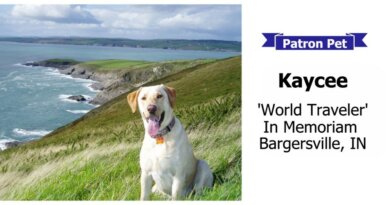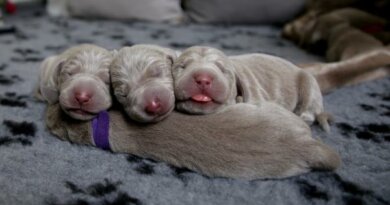What Is A Long-Haired German Shepherd? (Breed Basics 101)
This post may contain affiliate links. We may earn money or products from the companies mentioned in this post.
While the guide and service dog schools mainly use Labrador and Golden Retrievers we do also work with German Shepherds.
When I was out with my guide dog puppy I was recently asked if I ever raised a German Shepherd and more specifically what is a long-haired German Shepherd?
The long-haired German shepherd dog is a purebred variety of the ‘normal’ German shepherd which traditionally has a short or medium-length coat.
These beautiful dogs look very elegant, but they still have the lovable, reliable, and intelligent personality of the ‘normal’ German shepherd.
Although there are many crossbreeds between German shepherds and other dog breeds, such as huskies, which create a longer coat, the long-haired German shepherd is actually a purebred German shepherd.
The long-haired coat comes from a recessive gene, which means both parents need to be long-haired in order to produce a long-haired German shepherd puppy, and this makes them very rare.
Long-haired German shepherds have stunning, long coats that can be a variety of colors.
The coat requires additional attention which turns the long-haired German shepherd into a high-maintenance dog that requires a lot of attention to prevent hair and skin issues.
By the way, the answer to whether or not I raised a German Shepherd. No, I have not. But I have puppy sat several German Shepherd Dogs (GSD) puppies in training.
Keep reading to find out about the origins of this energetic breed, the grooming requirements of their long coat, and what it takes to take care of this majestic breed.
Origins Of The Long-Haired German Shepherd
The German shepherd was bred in Germany in the late 19th century by Captain Max von Stephanitz.
Von Stephanitz wanted to breed the best sheep herding dog Germany had ever seen.
Over 35 years of dedicated breeding, he eventually produced an apex herding dog which was the German shepherd.
The German shepherd was originally meant to be a working dog herding sheep and working on farms.
As the years went by, many people saw the benefits of an athletic, highly trainable, loyal dog, and the German shepherd found itself doing many different jobs such as police work, search and rescue, and working as a service dog for people with disabilities.
The German shepherd breed was designed to have a short or medium-length coat to keep the dog warm and protected from harsh winters and rough terrain.
The long-hair gene occasionally cropped up, and von Stephanitz was not a huge fan.
Von Stephanitz saw the long hair as being too high-maintenance for a working farm dog, and so he actively tried to breed it out of the German shepherd population.
This, combined with the fact the long-hair gene is recessive, has made the long-haired German shepherd very rare and difficult to find today.
Even though von Stephanitz tried to get rid of the long-hair gene from the population, it persisted.
Eventually, people started wanting the long-haired German shepherd because of its different looks; therefore, it has not been bred out of the German shepherd population completely.
Because the gene for long hair is recessive, the only way for a long-haired German shepherd puppy to be born is if both parents are long-haired German shepherds.
Physical Characteristics Of The Long-Haired German Shepherd
Most people have a pretty good idea of what a typical short-haired German shepherd looks like.
Let’s take a closer look at the long-haired German shepherd’s physical characteristics.
Size
The long-haired German shepherd has the same build as the short and medium-haired German shepherd.
| SEX | HEIGHT | WEIGHT |
|---|---|---|
| Male | 24 – 26 inches | 65 – 90 pounds |
| Female | 22 – 24 inches | 50 – 70 pounds |
Males and females both have a life expectancy of 7 to 10 years as a large breed.
Coloration
The long-haired German shepherd can be a variety of colors:
- Black
- Black and cream
- Black and red
- Black and silver
- Black and tan
- Blue
- Gray
- Liver
- Sable
- White
- Bi-color (dual color)
Coat
The long-haired German shepherd does not always have a double coat and is more susceptible to the cold and heat than its short and medium-haired counterparts.
The long-haired coat tends to split in half and create a path down the dog’s back. While this looks very nice and neat, it can have some negative side effects.
The coat can trap water down the back and cause skin irritation that leads to infection.
Grooming A Long-Haired GSD
German shepherds require a fair amount of grooming because they shed a lot throughout the year.
This is even more true for long-haired GSDs because their long coats get tangled, matted with dirt, and require daily brushing.
Using a tool/comb/brush specifically designed to help with deshedding and detangling long-haired coats will help you keep your dog’s coat in perfect condition.
A comb with long teeth will help get all the way through the coat to get tangles and shedding out, and a shorter brush will help smooth out the coat.
If the coat is left to tangle and mat, it will pull on the skin, which will lead to sores, irritation, and infection.
It is essential to run a comb or brush through their coat for at least a few minutes every single day.
Owing to the fact that they have long tufts of hair around their ears, their ears can trap dirt and become infected fairly easily.
Cleaning out your dog’s ears every second day will help keep them free of dirt and wax build-up.
Keeping Your Long-Haired German Shepherd Active
Aside from the grooming specifications mentioned above, the care your long-haired German shepherd needs is very similar to the care requirements of the short- and medium-haired
German shepherd with some small additional considerations.
German shepherds are incredibly active dogs and require a sizable amount of training and dedication from their owner.
Long-haired German shepherds are no different. These dogs also need to be trained from an early age to prevent behavioral problems from presenting later on in life.
You should exercise your long-haired GSD three times a day for 20 minutes.
The exercise can take the form of activities like going on walks, taking hikes, going to a reputable dog park, playing fetch in the garden if you have the space to run around, or intense training sessions.
Additionally, mental exercise is just as important as physical exercise and will tire your dog out as much as if they went for a jog around the block.
Puzzle toys, sniffing games, and obstacle courses are all excellent ideas for mental exercises.
Finally, keep in mind that because long-haired German shepherds lack an undercoat and have extra-long hair, they can struggle to regulate their body temperature and will overheat easily if they spend too much time out in the sun.
Is The Long-Haired German Shepherd The Right Dog For You?
Long-haired German shepherds are stunningly beautiful dogs and are high up on many people’s desired breed list.
However, these dogs are not for everyone, so it is important to consider whether your home and lifestyle is what this breed needs.
These questions can help you figure out if the long-haired GSD is the dog for you:
- Are you able to devote at least 10 to 15 minutes everyday to groom your long-haired German shepherd?
- Are you happy with your long-haired German shepherd spending most of its time indoors away from the elements?
- Are you able to devote an hour a day to exercise your long-haired German shepherd?
- Are you willing to devote a considerable amount of time to train your long-haired German shepherd?
FAQs
Do long-haired German shepherds get along with other dogs?
Provided your long-haired German shepherd has been correctly socialized with other dogs and pets from the time they were a puppy, yes, they get along very well with other dogs and pets.
Do long-haired German shepherds get along with children?
German shepherds, whether they are long-, medium-, or short-haired, are excellent family dogs and get along well with children.
For an in-depth look at why they fit well into families with kids, check out our dedicated article.
Are long-haired German shepherds more susceptible to diseases than short-haired German shepherds?
The hair gene does not affect their health either negatively or positively.
However, if their hair is allowed to tangle and mat, they can suffer from painful and severe skin conditions and infections.
Are long-haired German shepherd puppies expensive?
Finding a German shepherd puppy is relatively easy.
However, finding a long-haired German shepherd puppy can prove to be difficult because they are rare.
Their rarity often makes them more expensive.
As a personal aside, we have fostered and rescued many German Shepherd mix puppies over the years and some had a longer coat similar to the long-haired GSD. If you’re looking for this breed you may also want to check in on your local shelters and rescues.
Does the American Kennel Club recognize the long-haired German shepherd?
The AKC does recognize the long-haired German shepherd as a registered breed.
Rolling Over On The Long-Haired German Shepherd
The long-haired German shepherd shares almost all of its physical and behavioral characteristics with its more common short and medium-haired cousins.
The only real difference is the length of the breed’s hair.
They have a wide range of coat colors, such as:
- Black
- Black and cream, red, silver, or tan
- Blue
- Gray
- Liver
- Sable
- White
- Bi-color
The long-haired german shepherd is very rare because the gene for long hair is recessive, so it requires two long-haired parents to produce long-haired offspring.
While long-haired German shepherds are beautiful to look at, like all large breeds, they do come with their fair share of extra work to keep them well-groomed, happy, and healthy.
Do you have a long-haired GSD or are you looking to get one?
Tell us a little about your dog in the comment section below.
Save To Pinterest
Top Picks For Our Puppies
- BEST PUPPY TOY
We Like: Calmeroos Puppy Toy w/ Heartbeat and Heat Packs – Perfect for new puppies. Helps ease anxiety in their new home. - BEST DOG CHEW
We Like: Bones & Chews Bully Sticks – All of our puppies love to bite, nip, and chew. We love using Bully Sticks to help divert these unwanted behaviors. - BEST DOG TREATS
We Like: Crazy Dog Train-Me Treats – We use these as our high-value treats for our guide dog puppies. - BEST FRESH DOG FOOD
We Like: The Farmer’s Dog – A couple months ago we started feeding Raven fresh dog food and she loves it! Get 50% off your first order of The Farmer’s Dog.
Check out more of our favorites on our New Puppy Checklist.




